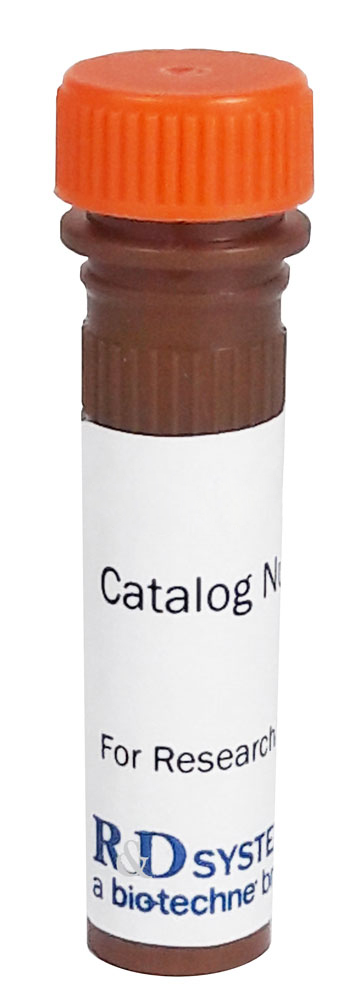Human NKG2C/CD159c Alexa Fluor® 594-conjugated Antibody Summary
cross-reactivity with the human NKG2A/CD94 heterodimer or with the human CD94 homodimer is detected.
Applications
Please Note: Optimal dilutions should be determined by each laboratory for each application. General Protocols are available in the Technical Information section on our website.
Reconstitution Calculator
Preparation and Storage
- 12 months from date of receipt, 2 to 8 °C as supplied.
Background: NKG2C/CD159c
Human NKG2C (NK cell Group 2 isoform C; Killer cell lectin-like receptor subfamily C, member 2) is a member of the C-type lectin-like superfamily of proteins. Natural killer (NK) receptors are expressed in both NK cells and cytotoxic CD8+ T cells and have both activating and inhibitory members (1-3). Regulation of the balance between the activating and inhibitory receptors is important and lack of such regulation has been implicated in autoimmunity (4). The NKG2 family includes seven receptors: NKG2A, -B, -C, -D, -E, -F, and -H, which is the longer isoform of NKG2E. Except for NKG2D and NKG2F, the NKG2 family members form heterodimers with CD94 (5, 6). NKG2C interacts with the adapter molecule DAP12 and acts as activating receptor when heterodimerized with CD94 (7). Human NKG2C is synthesized as a 231 amino acid (aa) protein that includes a 70 aa cytoplasmic domain, a 23 aa transmembrane segment, and a 138 aa extracellular domain (ECD). Within the ECD, human NKG2C shares 40% sequence identity with mouse NKG2C. NKG2C-CD94 heterodimers bind to the widely expressed nonclassical MHC-I molecule, HLA-E (Qa-1b in mouse), which presents a peptide derived from the signal peptide of classical MHC-I molecules (8, 9). Triggering the NKG2C-CD94 complex may activate the cytolytic activity and cytokine production of NK and CD8+ T cells (8, 10). Human cytomegalovirus (HCMV) infection promotes the differentiation and expansion of NKG2C+ NK cell subsets, possibly involving a cognate interaction of CD94/NKG2C with ligand(s) displayed by HCMV‑infected cells (11, 12). MAB1381 (clone 134522) displays potent agonistic activity and also blocks the binding of the NKG2C/CD94 heterodimer to HLA-E tetramers (13-15).
- Orbelyan, G.A. et al. (2014) J. Immunol. 193:610.
- Tassi I. et al. (2006) Immnunol Rev. 214:92.
- Lanier, L.L. (2008) Nat. Immunol. 9:495.
- Schleinitz, N. et al. (2010) Immunology. 174:2878.
- Lopez-Botet, M. et al. (2000) Hum. Immunol. 61:7.
- Braud, V.M. et al. (1998) Nature. 391:795.
- Lanier, L.L. (1998) Immunity 8:693.
- Vance, R.E. et al. (1999) J Exp Med 190:1801.
- Kaiser B.K. et al. (2005) J Immunol 174:2878.
- Bellón T. et al. (1999) J Immunol 162:3996.
- Pupuleku A. et al. (2017) Front Immunol. 8:1317.
- Hammer Q. et al. (2018) Nat Immunol. 19:453.
- Alici, E. et al. (2008) Blood 111:3155.
- Coupel, S. et al. (2007) Blood 109:2806.
- Fausther-Bovendo, H. et al. (2008) AIDS 22:217.
Product Datasheets
Product Specific Notices
This product is provided under an agreement between Life Technologies Corporation and R&D Systems, Inc, and the manufacture, use, sale or import of this product is subject to one or more US patents and corresponding non-US equivalents, owned by Life Technologies Corporation and its affiliates. The purchase of this product conveys to the buyer the non-transferable right to use the purchased amount of the product and components of the product only in research conducted by the buyer (whether the buyer is an academic or for-profit entity). The sale of this product is expressly conditioned on the buyer not using the product or its components (1) in manufacturing; (2) to provide a service, information, or data to an unaffiliated third party for payment; (3) for therapeutic, diagnostic or prophylactic purposes; (4) to resell, sell, or otherwise transfer this product or its components to any third party, or for any other commercial purpose. Life Technologies Corporation will not assert a claim against the buyer of the infringement of the above patents based on the manufacture, use or sale of a commercial product developed in research by the buyer in which this product or its components was employed, provided that neither this product nor any of its components was used in the manufacture of such product. For information on purchasing a license to this product for purposes other than research, contact Life Technologies Corporation, Cell Analysis Business Unit, Business Development, 29851 Willow Creek Road, Eugene, OR 97402, Tel: (541) 465-8300. Fax: (541) 335-0354.
FAQs
No product specific FAQs exist for this product, however you may
View all Antibody FAQsReviews for Human NKG2C/CD159c Alexa Fluor® 594-conjugated Antibody
There are currently no reviews for this product. Be the first to review Human NKG2C/CD159c Alexa Fluor® 594-conjugated Antibody and earn rewards!
Have you used Human NKG2C/CD159c Alexa Fluor® 594-conjugated Antibody?
Submit a review and receive an Amazon gift card.
$25/€18/£15/$25CAN/¥75 Yuan/¥2500 Yen for a review with an image
$10/€7/£6/$10 CAD/¥70 Yuan/¥1110 Yen for a review without an image


